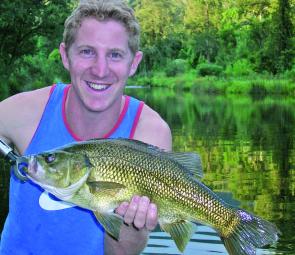Unstable weather has made it difficult for offshore anglers to make the most of the Springtime run of striped and yellowfin tuna which bring the inshore and offshore waters to life at this time each year.
Those who have been able to get wide have found yellowfin to 40kg and striped marlin to 90kg in good numbers. Most fish have taken trolled skirted lures with the waters wide of South Solitary Island to the shelf producing great action.
Further inshore, there have been schools of smaller yellowfin tuna to 18kg feeding on the bait schools that are taking refuge over the inshore reefs in 20m to 40m.
Slow-trolled hard minnows and live baits work well inshore with kingfish, tailor and tuna hitting aggressively near reefs and island washes.
Beach anglers have found whiting, bream and school jewfish keen to take worm baits, with the best bream coming from Boambee Beach, whiting from North Beach near Mylestrom and school jew from Woolgoolga Back Beach.
I have heard there are a few jewfish taking lures around the rock washes, with big fish on the chew at Sawtell and Gallows headlands and school fish caught at Gallows and Sapphire/Woolgoolga headlands.
If you are chasing jew on lures then try 6” plastics, 1/2oz jig heads, 30lb braid and 50lb leader. Cast your lures next to cover and work them patiently back across the sand or gravel bottom.
Fish normally hit on the first, second or third hops but if you're standing on an undercut or deep ledge, don't be surprised if the odd bigger fish shoots out from under your feet to hit the lure just before it is lifted out of the water.
In the creeks the luderick are still biting well, as are flathead and whiting near the river mouths at Urunga, Nambucca and Red Rock.
Last weekend the first rumours of mangrove jack hook-ups started to filter through the grapevine. At this early stage of the season, bigger fish move into the creeks and are very aggressive lure takers.
As the season unfolds, fish become increasingly lure-shy, with live baits the best method.
All the creeks from Nambucca to the border hold good populations of big jacks. You'll need a heavyweight barra-style rod, 40lb braid and at least 60lb leader if you're going to stop the bigger fish. Nowadays we use 40lb mono wire when using live mullet.
Mike Colless has continued his good early-season form on the bass with several solid 40cm-plus specimens visiting his new canoe long enough for a photo.
As with the jacks, all the Coffs Coast rivers have a brackish and then a freshwater stretch and jacks and bass can be caught in all these systems.
If you want to have a crack at catching bream, jacks and bass on the one trip, try some of the shorter tidal rivers and creeks down near Macksville. If you're interested only in jacks then don't stray too far from the Pacific Highway and target the smaller systems.
If you want the classic bass-only experience, head up the bigger systems that have longer freshwater stretches that flow downhill from the ranges.
The biggest of these is the Clarence River. A good place to start your Clarence bass fishing is at Copmanhurst, where a boat can be launched and you then get access to the Orara River, which can turn on some great tight-water action.
The trick to fishing this area is to avoid it after heavy rain, the clearer the water the better the fishing.
If you're feeling more adventuress then head about 50 minutes further west from Copmanhurst and visit the famous Clarence Gorge area for canoe, boat or shore-based angling can take place.
Over the coming month I'll be heading north to do some impoundment barra casting before coming back to do battle with the jack population around Coffs.
Reads: 3668
A nice bass creek, an early morning and a canoe – what more could you ask for?Pics: Dale Graham.

Aaron Miller caught this hungry 50cm bass on a fizzer.

This tree frog was regurgitated from Aaron's 50cm bass on capture.

Dale Graham with another solid bass from the surface.




